Telephone and e-consultation are available when sought. Contact Us to arrange.
Telephone and e-consultation are available when sought. Contact Us to arrange.
The natural sits inside the eye and it helps with focussing of light onto the retina (back of the eye). As we age, the natural lens becomes cloudy (formation of cataract) leading to blurring of vision and altered focus.
Cataracts usually develop in both eyes, but it is not uncommon to have variable levels of clouding and focus changes between the 2 eyes.
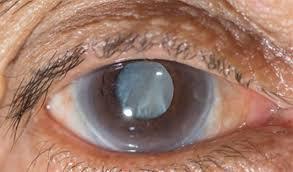
Cataracts most commonly develop as a part of the natural ageing process. However, there are other conditions which can bring about cataract formation, including:
With cataracts, the vision gradually becomes foggy making daily tasks difficult. Sometimes essential activities like driving can be compromised (especially at night). Vision with a cataract is like looking through a frosty or dirty window.
Other than fogging of vision, cataracts can also cause:
Most patients seek surgery when vision disturbances from the cataracts begin to interfere with their lifestyle or daily activities.
Some patients may consider proceeding with surgery at the earliest stages because the advanced surgery options allow for them to become glasses free at the same time that they have their cataract surgery.
Others want to wait till the vision is significantly affected. A word of caution here – because cataracts come on gradually it may not be obviously apparent to some patients that their vision is very poor, especially if their daily activities are quite limited. In these situations, the doctor will guide the patient on the benefits of progressing with surgery. Patients often take this guidance on board and progress on, and almost always feedback that they were glad they took the doctor’s advice.
It is common for patients to ask – Is there any way to treat cataract other than surgery?
Surgery is the only way to treat cataracts by replacing the cloudy natural lens with an artificial clear lens implant.
With modern technology, cataract surgery is a safe and quick procedure. Our specialists are very experienced & world renowned cataract surgeons with extremely high success rates and low complication rates. They will take you through your entire treatment journey step by step taking your individual circumstances into account.
Surgery is mostly done under local anaesthetic with some numbing drops or with a small volume local anaesthetic gently injected painlessly around the eye.
Patients often ask –
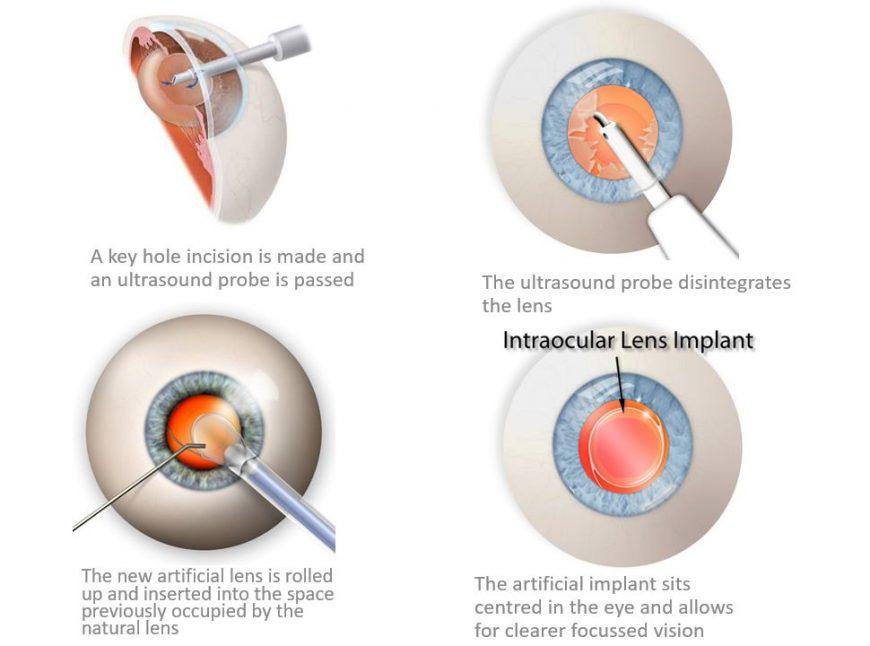
There are a wide variety of replacement lens implants, called Intraocular lenses (IOL) available for use at cataract surgery. The decision of which is the lens for you will depend on multiple factors which will be part of your detailed pre surgical consultation.
These lenses have a single focus. Typically the lens is chosen to allow for distance focus. In the NHS this is the implant that is routinely available as part of “Standard” cataract surgery.
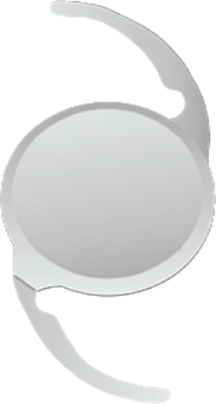
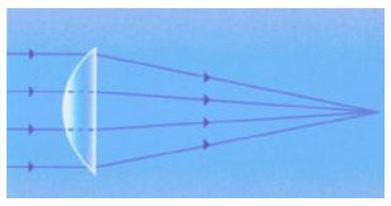
With these lenses patients are able to achieve clearer vision but with dependence on glasses for aspects of vision.
Surgery can be enhanced using “Advanced” premium lens implant technologies which can be personalised to the individual. Extremely high degrees of precision can be achieved with correction of focus and therefore minimising dependence on glasses after surgery. Similar level of precision is achieved as laser corrective surgery and the additional elements are done at the same time that the cataract surgery is undertaken.
These advanced methodologies are not routinely available through the NHS because their purpose is for the cosmetic effect of reducing dependence on glasses.
The whole range of premium lens technologies are available if you chose to have private cataract surgery with us.
These are specialized lenses that have different curves in different axes to counteract the axes shape abnormalities in patients’ eyes. It is used when astigmatic incisions alone will not be sufficient in higher errors. Patients achieve excellent glasses free vision from these. Note the fine lines on the lens which the surgeon uses to align the lens to marks made on the eye at a pre-calculated axis.

These specialised lenses enable a patient to see distance and near with minimal to no dependence on glasses.
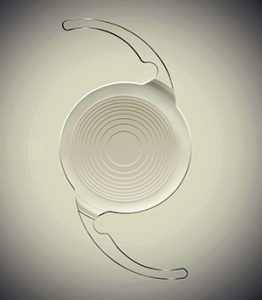
How these work: The lenses have micro-rings built in their very precise technological design. The rings enable light to bend differently when arriving from different distances thereby allowing focus for light coming from distance and near objects.
The diagram below shows how 3 focal distances corresponding to distance, intermediate and near are achieved with multifocal lenses.

Compare this to a standard lens below where there are no rings or segments and therefore cannot focus different distances.
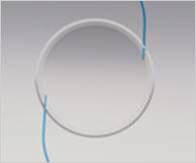
This is a state of the art system which allows the multifocal lens to be split into components – the distance part (no ring elements) and the near part (with the ring elements). This allows for a future adjustment where the near part can be removed easily if there are any future wear and tear changes in the eye that could benefit from removal of the ringed component.
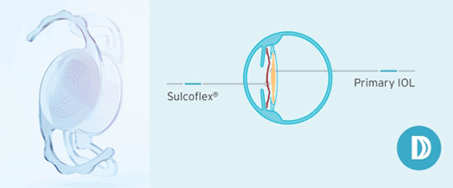
These specialised designs can simultaneously correct astigmatism and provide multidistance vision (distance & near). It combines the mechanisms of the lenses as described above to achieve these effects.
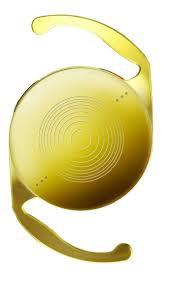
These are specially designed lenses that allow for a degree of multifocality but without the ring or segmented design. The advantage is that it significantly reduces the potential side effects of glare, haloes, contrast reduction, & ghosting which are inherent to multifocal lens technologies, whilst delivering some intermediate distance vision function that is greater than with a mono distance lens.
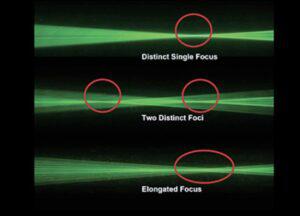
The ray focus picture on the left shows how instead of having a single focus point as would be seen with a monolens (top example), or multiple focal points as would be seen with a multi lens (middle example), there is an extended focus (bottom example). This is achieved by a clever technique of making the central part of the lens curvier as shown by the blue lens power maps in the picture on the right. The central green part on the left map shows the stronger central power. Compare this to a standard mono lens on the right map which has a more uniform power across its surface. The extra power from the central green zone is what gives the extra reading focus in this format of lens.
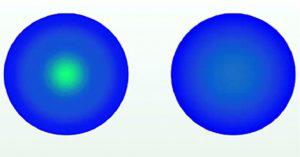
In this technique we use a specialised laser (called excimer) to fine tune the result following lens surgery when necessary. This enables very high levels of accuracy in focus for patients.

| NHS surgery | Private cataract surgery with Eye Correction Centre |
|---|---|
| waiting times are prolonged and variable | waiting times from referral to surgery is usually 2 weeks |
| longer gap between eyes (several weeks to months) | few days to a week between eyes – therefore faster overall settling |
| Patients can be in training lists | Only the consultant expert who saw you initially will do your surgery |
| Pre-op assessments & Post op care is often delegated to associate non consultants | Pre-op assessments & Post op care is with your operating specialist consultant |
| Routinely – Standard surgery only available with mono implants | Routinely – Advanced surgery available with premium lens implants |
| Custom excimer laser focus enhancement not available | Custom excimer laser focus enhancement is available |
| Choice of surgeon is not possible in most cases | Your surgeon will be the same expert you chose for your initial consultation |
| Choice of dates for surgery is not possible in most cases | High level of choice of dates for surgery is available allowing patients to plan their lives more easily |

Standard Cataract surgery is routinely available to patients and has proven itself safe and effective. Patients are able to achieve clearer vision but with dependence on glasses for aspects of vision.
Patients commonly ask –
What is the required care after cataract surgery?
Patients are provided all the drops needed for the 4 weeks after their cataract surgery. There are 3 drops that come in easy-to-use droppers; an antibiotic, a steroid anti-inflammatory and a non-steroidal anti-inflammatory. These are gradually reduced over the weeks.
Dos and don’ts instructions are provided at the point of listing. Most of these are common sense instructions and should be easy to follow.
Within a day or two patients will notice being able to see very well without glasses. The different techniques all achieve the same end result of good vision.
Patients commonly ask:
When can I drive after the surgery?
Most patients are able to drive a week after their cataract surgery after the specialist has checked and cleared them to do so.
When will I notice an improvement in my vision?
Most patients notice significant improvement in the clarity of vision the day after their cataract surgery. Improvements continue over the following weeks.
Do I need to wear glasses after cataract surgery?
With standard cataract surgery most patients will get distance vision without glasses at the driving standard or more. They will however need glasses for reading. Patients with astigmatism will also need distance glasses correction.
To correct astigmatism and reading vision, premium lens technologies can be used via Advanced private cataract surgery available through the Eye Correction Centre. (e.g Toric lens, Multifocal lens and Extended depth of focus lens). With this most patients can get high levels of glasses independence for distance AND near vision after surgery.
Also for patients having private cataract surgery they have access to state of the art customisation of the results using laser enhancement techniques. This increases the percentage probability of distance focus correction from 90% (in standard cataract surgery) to 99% (in advanced private cataract surgery).
What are the risks from cataract surgery?
As with all forms of surgical treatments there are risks of unpredictable outcomes and complications. As a general rule of thumb patients can expect a 95% chance of achieving functional vision to a high standard (corresponding to their best vision potential) from their initial surgery. 1-5% of patients may have some difficulties but in the majority of cases these can be managed. The risk of severe and lasting problems is very low at 1:2000 or less per eye (so both eyes getting affected is very rare indeed).
Click here to see detailed price list for all consultations and procedures
We offer a comprehensive eye service delivered through specialist and generalist eye doctors.
Please click here to read on all our speciality procedures
Please note: Whilst these are the general suitability criteria, individual criteria has to be taken into account for specific patient needs and the appropriate procedure applicable.
We are not a cut-price service because quality does not come by making compromises. However we are competitive and transparent in our pricing structure. We make efforts to ensure that patients are made aware of all price points in advance of any consultations/investigations and procedures, to enable our patients to make an informed choice on how they would like to proceed. Read more on the details of our prices
We work with all insurers. Please refer to the above FAQ on “Pricing” for full details. Please note – even if your insurer is not on the list of companies provided, let us know and we can help to make arrangements. Read more on the insurers we work with – listed at the end of our Pricing section
As a general rule of thumb patients can expect a 95% chance of achieving functional vision to a high standard (corresponding to their best vision potential) from their initial surgery.
As with all forms of surgical treatments there are risks of unpredictable outcomes and complications. 1 to 5% of patients may have some difficulties but in the majority of cases these can be managed. The risk of severe and lasting problems is very low at 1:2500 or less per eye (so both eyes getting affected is very rare indeed).
You will of course be given a full explanation of the specific risks and benefits of the individual procedure applicable to you at the time of the consultation.
Eye doctors are at least five times more likely as the general public to choose vision correction surgery for themselves. The study, featured in the Journal of Cataract and Refractive Surgery, surveyed 250 surgeons who perform LASIK. Of those, 62.6 percent said they have already undergone LASIK to correct their vision, and 91 percent said they have done it or recommended it for their immediate family members.









Wilmslow
Macclesfield
Warrington
Abergele